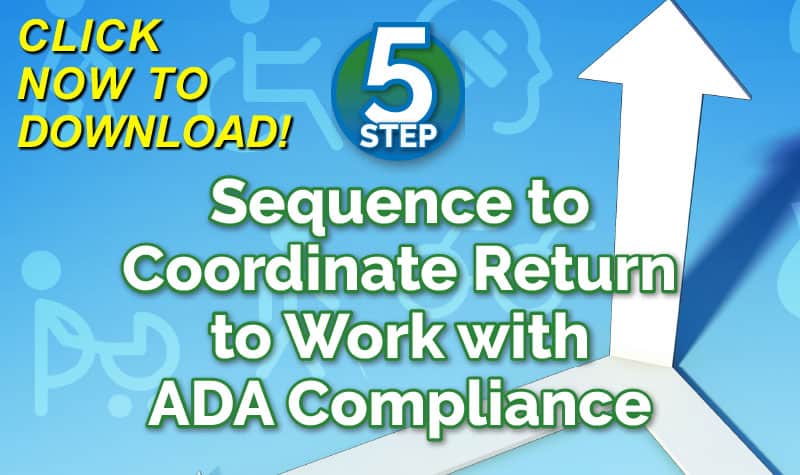The most conscientious employer can trip up when it comes to combining their state’s workers’ compensation law with the Americans with Disabilities Act (ADA) law and the Family and Medical Leave Act (FMLA) law. Unintentional and inadvertent violations of one of the laws can occur when the employer is focusing on their state’s workers’ compensation requirements or on ADA or on FMLA, and not considering the other two laws and how they relate and overlap. As an employer, you must take into consideration the various complications that can arise when you analyze each work comp injury in the light of either ADA requirements or FMLA requirements.
Definitions: ADA of 1990 protects disabled employees from discrimination due to their disability.
FMLA of 1993 permits employees to take unpaid time off, up to 12 weeks in a 12 month period, due to their own medical issues (FMLA also covers employees off work due to a family member but that is outside the scope of this article).
Click Link to Access Free PDF Download
“13 Research Studies to Prove Value of Return-to-Work Program & Gain Stakeholder Buy-In”
Eligibility: Work comp applies to any employee who has an injury or illness arising out of or in the course of employment. ADA applies when the employee has a disability, physical or mental, that substantially limits major life activity, or has a history of such impairment, or is regarded by others as having an impairment. FMLA applies when the employee has a serious health condition, whether illness, injury or impairment, that requires either continuous treatment of more than 3 days and at least 2 treatments or inpatient care.
Applicable: With work comp any employee is covered while unable to work during the injury or illness recovery period. With ADA, the employee is covered if the employee is a “qualified individual with a disability” and is performing the essential functions of their job without any accommodation or with “reasonable accommodation” by their employer. With FMLA, the employee must be unable to perform the functions of the position due to the medical condition to qualify for leave under FMLA.
Benefits: In work comp, the employee normally receives up to two-thirds of their wage rate (maximum and minimum caps) for time missed from work plus medical expenses plus a permanent disability award, if any. Under ADA, there is no benefit requirement mandated by law for a paid leave, but if the employer grants sick leave time to all employees, it can not be denied to an employee because of the disability. A FMLA leave is unpaid time off, however, the employee may take sick days, vacation days or disability leave with pay, unless the person is receiving workers’ compensation benefits.
Company Size: For work comp, all employees are covered unless the employer is a very small company and has less than the minimum required number of employees for work comp coverage. ADA applies to all employers with 15 or more employees. FMLA applies to employers with 50 or more employees within 75 miles of the employee’s work location, and the employee has been employed at least 12 months and worked at least 1,250 hours within the previous year.
Return To Work/Light Duty: With work comp, the employer may require the employee to work light duty/modified duty if medically approved. With ADA, the employee may require the employer to provide a light duty position as a reasonable accommodation, if light duty is available and feasible. With FMLA, the employer cannot require the employee to take a light duty job, but the employee may elect to do so, if a light duty job is available.
The Work Comp/ADA/FMLA Claim: As an employer you need to know when and how to apply the state work comp statute, the ADA and the FMLA.
A Case Study
Karen works for your company as a secretary/transcriptionist for several years. Since your company employs more than 50 employees at Karen’s office location, your company is subject to the work comp statutes, the ADA and the FMLA. Karen is an employee who misses work frequently and has used up all her allotted sick leave days.
One Tuesday morning Karen calls in and you expect to hear she has another cold or some other ailment, but instead Karen reports that both of her wrist have been hurting her for some time. Both of her wrists have become painful and she cannot use her hands. She went to her doctor yesterday after work. The doctor has advised her not to return to work until he can see her again next week. As you don’t know what is the cause of the wrist pain, and as Karen has no more sick time available, you advise Karen that her time will be covered under the FMLA (off work more than 3 days and two or more medical visits) and will not be paid time off.
The following Tuesday Karen calls in again and advises the doctor has now diagnosed her with bilateral carpal tunnel syndrome and has related her bilateral carpal tunnel syndrome to her job duties. Karen is now requesting work comp benefits claiming the wrist pain is most strongly associated with her job responsibilities. The claim is accepted as work comp and Karen has surgery on both wrist, which turns out to be only partially successful.
After three months Karen returns to work light duty and wants the same job she had before. However, Karen medical condition prevents her from being as productive as she was before, qualifying her as disabled under ADA. If Karen can perform the same essential functions as before with “reasonable accommodations,” per ADA, she is entitled to her old job. With FMLA, Karen is entitled to her original job or an equal job with the same pay and benefits IF she can perform the essential functions of her job, but under FMLA there is no requirement of reasonable accommodations like there is under the ADA.
FREE DOWNLOAD: “13 Research Studies to Prove Value of Return-to-Work Program & Gain Stakeholder Buy-In”
Even though you are accommodating Karen’s workers’ compensation light duty restrictions, and have made reasonable accommodations to comply with ADA, Karen decides the work is too difficult and causes too much pain. As Karen’s doctor has released her to light duty, you can stop the work comp indemnity benefits, but Karen can still use FMLA for time off. She can apply for and use 12 weeks less all previously used time under FMLA time in the last 12 months. You should require Karen and all employees to use all available paid time off — sick time, if any, and all vacation time, if any — before allowing the unpaid FMLA leave, to prevent her from going on vacation at the end of her FMLA leave.
After Karen has no more work comp indemnity benefits as her doctor previously approved her for light duty, and she has exhausted her sick leave time, vacation time and her unpaid FMLA time, Karen provides medical certification from her doctor that she can return to work. Under FMLA your company has to take her back to her original position or equivalent position. Now, if Karen advised you she can return to work full time, if your company will make reasonable accommodations for her including an ergonomically correct chair, a new keyboard and a break from typing every two hours, you are obligated to do so under ADA, as you can make those accommodations. (workersxzcompxzkit)
In Summary: The burden is on the employer to know all the requirements of the state work comp laws, the ADA and the FMLA. If there is a conflict between the statures, the Federal statutes — ADA and FMLA — take precedent over the state work comp statutes. Smart employers educate themselves for all three sets of laws and comply with all three.
Podcast/Webcast: How To Prevent Fraudulent Workers’ Compensation Claims
http://www.workerscompkit.com/gallagher/podcast/Fraudulent_Workers_Compensation_Claims/index.php
TD Calculator: www.ReduceYourWorkersComp.com/transitional-duty-cost-calculator.php
WC Calculator: http://www.reduceyourworkerscomp.com/calculator.php
Do not use this information without independent verification. All state laws vary. You should consult with your insurance broker or agent about workers’ comp issues.
©2009 Amaxx Risk Solutions, Inc. All rights reserved under International Copyright Law.









